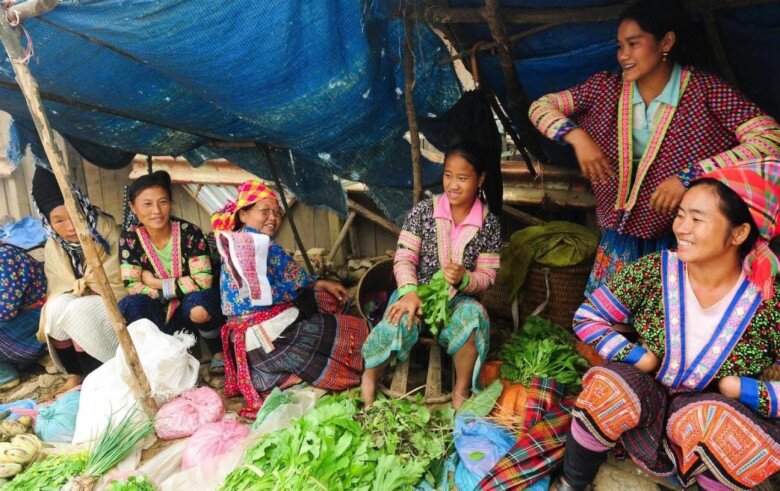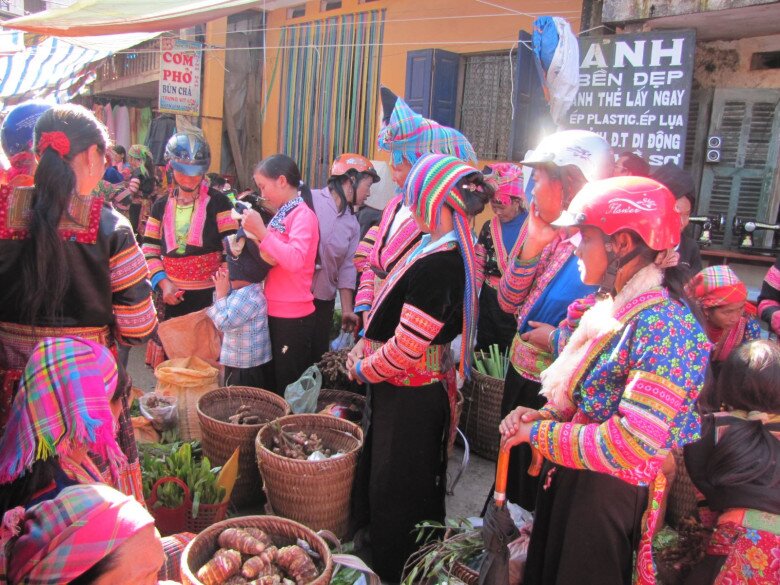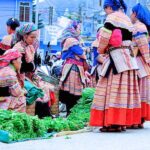As the morning mist still blankets the mountain slopes, the trails come alive with the sounds of flutes, panpipes, and mouth harps. The Hmong and Dao people, adorned in their vibrant traditional attire, carry their children, lead their horses, and transport goods on their backs or in baskets. The lively atmosphere resonates with laughter and chatter, creating a vibrant scene in this highland region.

The market is more than just a place for trading; it is a gathering hub and a cultural exchange for the local communities. For the ethnic groups in the area, the market is an opportunity to connect with loved ones and friends, share stories, exchange life experiences, and learn from each other’s livelihoods. Some come to purchase essential items, while others bring a few items to sell, such as a chicken or some wild vegetables. Regardless of the reason, the weekly market day is always a significant event.
Unlike the bustling and chaotic markets in the lowlands, the Sin Ho market has a unique ambiance. Both buyers and sellers approach the day with a relaxed and friendly mindset. There is no pushing or aggressive haggling. Sellers display their goods, and buyers purchase what they like without any pressure.

The goods brought to the market are diverse but primarily consist of produce and products from the mountains. These may include wild vegetables, juicy plums, corn liquor, jars of pure forest honey, piglets carried under the arm, free-range chickens, medicinal herbs, traditional medicines, or rare wild orchids. The value of these items lies not in their quantity or packaging but in their authentic quality and the stories behind their creation.
One of the highlights of the Sin Ho market is its culinary offerings. In the chilly highland climate, there’s nothing better than a steaming bowl of ‘thang co’, a traditional herbal soup, a sour pho infused with forest flavors, or a few shots of strong Mong Ke corn liquor. Dining here is not just about satisfying hunger but also about savoring unique flavors, engaging in conversations, and forging connections. Many love stories have blossomed amidst the sounds of the panpipes and flutes, fueled by the warmth of the liquor.

Each market day is like a miniature traditional fashion show. The Hmong women flaunt their vibrant pleated skirts, while the Dao women showcase their intricate five-color scarves and clothing. Everyone dresses in their finest, most elaborately embroidered outfits, proudly displaying their cultural identity and ethnic pride.
The intricate hand-embroidered patterns and motifs on the skirts and blouses reflect not only the artisans’ skill but also their communities’ aesthetic sense, beliefs, and spiritual lives. For visitors, this is a rare opportunity to admire and gain a deeper understanding of the highland culture through their distinctive attire.
Beyond being a trading hub, the Sin Ho market is also a fascinating destination for travelers eager to explore the beauty of the Northwest. After the market, visitors can venture to nearby villages like Ta Phin (home to the Dao people) or Xa De Phin (a Hmong settlement) to learn about traditional architecture, customs, and crafts such as embroidery and weaving. They can also hike to the legendary Da O Mountain and Ong Tien Cave, immersing themselves in the region’s mythical landscapes.

The region offers a peaceful mosaic of black-roofed stone houses, meandering paths through herb gardens, and the laughter of children playing in the fields. It is a picture of tranquil beauty and rustic charm.
In an era of rapid modernization, the Sin Ho market has retained its unique character, which is commendable. Local authorities have actively worked to preserve and promote the cultural value of the market by organizing cultural events, promoting tourism, and supporting the local communities in improving their product quality.
The Sin Ho market is not just a place of commerce but also a custodian of cultural memories, a bridge connecting the past with the present and tradition with development.
The Sin Ho highland market is not only vibrant with buyers and sellers but also vibrant with cultural hues. It exudes simplicity in its lifestyle and richness in its culinary traditions. For those who have visited, the market leaves an indelible impression of a dynamic cultural space where every step brings you closer to enduring spiritual values. Come and discover a highland region that is not just about mountains and forests but also about human warmth, unique culture, and distinct identity.
The Hidden Gem of Mai Chau: A Bustling Night Market that Captivates All with its Authentic Mountain Culture Charm
Nestled amidst the majestic mountains of Northwest Vietnam, Pa Co Night Market is more than just a hub for trade. It is a vibrant cultural space where the local community gathers to connect and preserve their rich traditions. Amidst the breathtaking landscape, this market comes alive after dusk, offering a unique glimpse into the local way of life. It serves as a melting pot of cultural exchange, where the indigenous people proudly showcase their heritage, creating an enchanting experience for all who visit.
The Ultimate Sapa Market: A Treasure Trove of Unique Delicacies
The Sapa Market is a bustling hub of activity, offering not just a place to trade goods but also a vibrant cultural exchange for the ethnic minority communities. With a lively atmosphere, the market comes alive with the vibrant colors of traditional costumes and the tantalizing aromas of local specialties. A visit to Sapa is truly incomplete without immersing oneself in the vibrant energy of this foggy city’s iconic market.
The Ultimate Northwest Mountain Passes: A Breathtaking, Otherworldly Adventure and a True Rider’s Challenge
Unveiling the mysteries of Northwest Vietnam, this journey is not just about exploring unique ethnic villages but also about conquering the four majestic mountain passes. From the mighty “King of Passes”, O Quy Ho, to Ma Pi Leng, the gem of Ha Giang, each pass has its own captivating stories and breathtaking sceneries to offer.



































